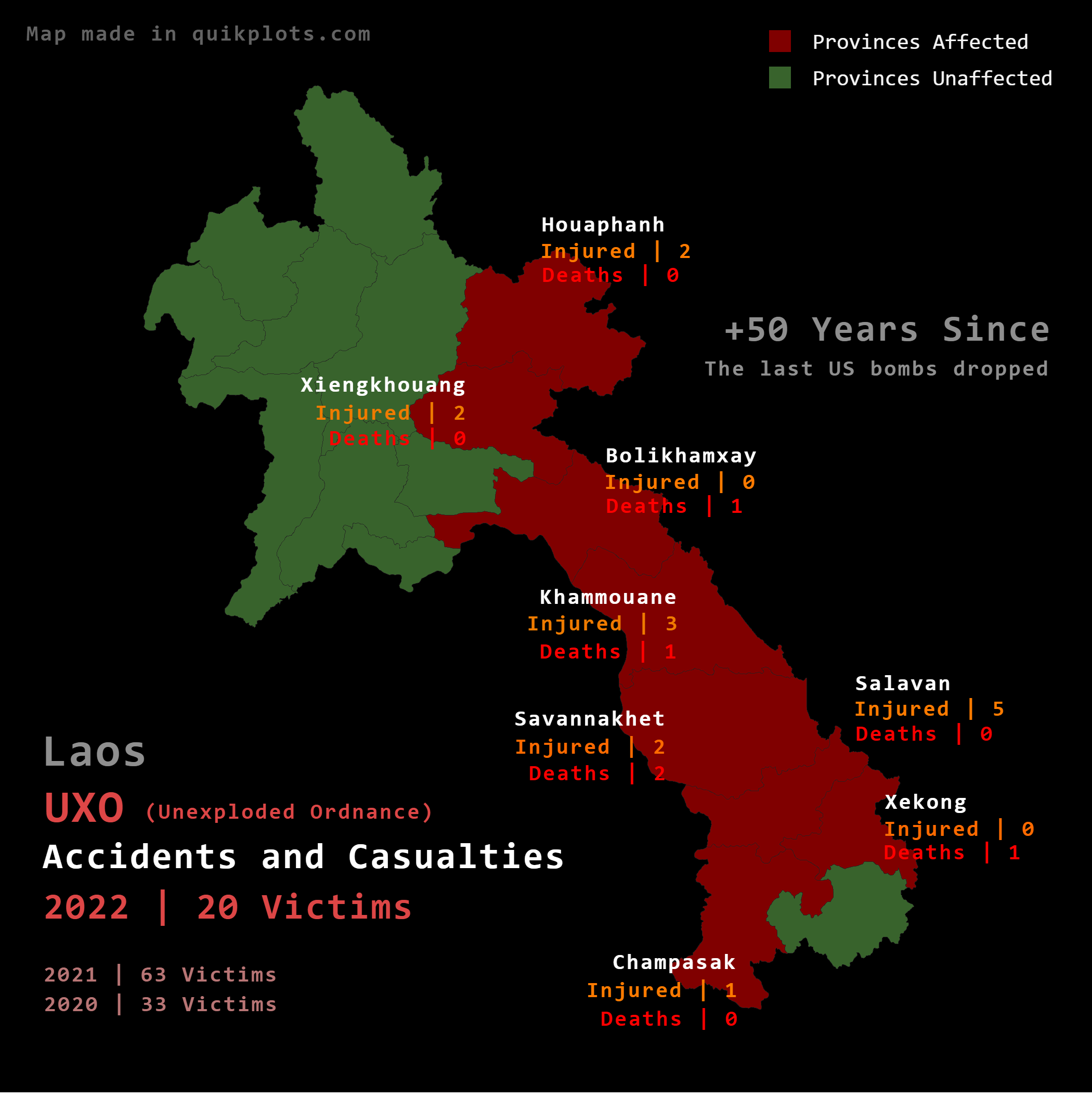UXO Accidents and Casualties Map in Laos 2022


Marcus Rodriguez
Historical Geography Expert
Marcus Rodriguez specializes in historical cartography and geographic data analysis. With a background in both history and geography, he brings unique...
Geographic Analysis
What This Map Shows
The map titled "Accidents & Casualties by UXO in Laos 🇱🇦 [2022]" provides a stark visualization of the ongoing impact of unexploded ordnance (UXO) in Laos, even more than five decades after the end of the Vietnam War. The visualization details the number of casualties and injuries reported across various provinces in Laos for the year 2022. This cartographic representation serves as a crucial reminder that the remnants of conflict continue to pose significant risks to local communities, revealing a grim legacy of war that has not yet been fully resolved.
Deep Dive into UXO in Laos
Laos holds the unfortunate title of being the most bombed country per capita in history, with an estimated 2 million tons of unexploded ordnance still scattered across its landscapes. Between 1964 and 1973, the United States dropped over 580,000 bombing missions, releasing more than 2 million bombs. Most of these bombs were dropped during the secret war in Laos, aimed at disrupting North Vietnamese supply lines along the Ho Chi Minh Trail. However, the aftermath of this extensive bombing campaign has created a persistent threat to the safety and well-being of the Laotian populace, particularly in rural areas where agriculture is the backbone of the economy.
Interestingly, UXOs are not just relics of war; they are deadly remnants that continue to claim lives and inflict injuries. According to the UXO Annual Report 2022, there were 56 recorded casualties related to UXOs in Laos during the year, including fatalities and severe injuries. It is crucial to note that these numbers only account for documented cases, and the actual figures may be much higher given the challenges in reporting and the remote nature of many affected areas. What’s fascinating is that many victims are often farmers or children who accidentally come into contact with these dangerous remnants while tending to their daily activities.
The types of UXOs vary, including cluster munitions, bombs, and landmines, each presenting different levels of risk. Cluster munitions, which release smaller submunitions over a wide area, are particularly hazardous since many of these submunitions fail to detonate upon impact, remaining a threat for decades. The ongoing efforts to clear these UXOs are vital, yet they face numerous challenges, including funding constraints and the sheer volume of land that needs to be surveyed and cleared.
Regional Analysis
Examining the map, we can observe variations in UXO-related casualties across different provinces in Laos. For instance, the provinces of Xieng Khouang and Savannakhet, known for their heavy bombing during the war, report higher numbers of UXO incidents compared to other regions. Xieng Khouang alone accounted for a significant portion of the reported casualties in 2022, a trend that echoes historical data showing it as one of the most bombed areas in the country.
On the other hand, provinces like Vientiane and Luang Prabang, while still impacted by UXO, show comparatively lower casualty rates. This discrepancy can be attributed to several factors, including the level of awareness and education about UXO risks, the effectiveness of clearance operations, and the population density in these regions. Interestingly, areas with proactive community education programs tend to report fewer accidents, underscoring the importance of awareness in preventing UXO-related injuries.
Significance and Impact
The significance of the UXO issue in Laos cannot be overstated. Beyond the immediate human cost of accidents and casualties, the presence of UXOs hampers agricultural development, limits access to land, and poses challenges to socioeconomic growth. Farmers living in UXO-prone areas often face the fear of losing their lives or limbs while working their fields. As such, the persistent threat of UXOs is a barrier to progress and development, keeping communities in a cycle of poverty and insecurity.
Current efforts to address the UXO crisis include extensive clearance programs supported by international organizations and donor countries. However, progress is slow, and the need for more robust funding, technical assistance, and community engagement remains critical. Looking ahead, it is essential for stakeholders to prioritize UXO education and clearance initiatives to ensure that future generations can live free from the fear of these hidden dangers.
Overall, this map serves not only as a visualization of the current state of UXO-related accidents and casualties in Laos but also as a call to action for continued efforts to address the legacy of war and foster a safer, more secure environment for all Laotians.
Visualization Details
- Published
- October 3, 2025
- Views
- 40
Comments
Loading comments...